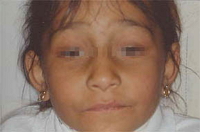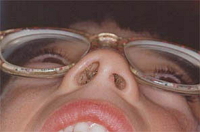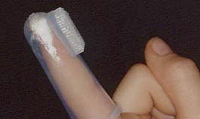DENTAL CARE IN CHILDREN PATIENTS BORN IN CONDITIONS OF HIGH BIOLOGICAL RISK OR WITH ESTABLISHED INJURIES
|
Description |

Facial appearance in a girl with palpebral ptosis and congenital visual deficiency.
To approach the possibilities of prevention and pediatric dentistry therapy to the child population that is affected by some type of physical or psychic diversity, after an individualized assessment of each case and specific pathology.
|
How does it work |

Girl born in conditions of high biological risk. It presents asymmetry in the nostrils derived from the nasotracheal intubation.
After a previous contact with the population to be analyzed through special education centers, hospitals or study groups, an analysis of the condition of each child is carried out. A previous survey sent to the parents provides information about current or previous illnesses, previous dental experiences, etc., with the purpose of producing a detailed and individualized form for each child.
At the same time, there is an exchange of information between pediatric dentists and educators, parents and pediatricians, in order to make known the pathology most frequently established in these population groups. After the analysis of the oral health status of each child, the corresponding report is made.
Health strategies are then established to preserve oral health in these children, considering that in cases where the disease is extensive, the possibilities of oral care may be very limited. For all of the above, prevention is especially relevant since the moment pregnancy is considered high risk, establishing programs of follow-up and care in conjunction with the pediatrician, parents and special educator.
|
Advantages |

Systems should be devised to facilitate the oral hygiene of these children, taking advantage of developed capacities and adapting and creating new methods.
It allows to reach the child born in conditions of high biological risk, or with pre-established injuries, an oral health plan individualized to their specific needs, with the purpose of minimizing the pathology most frequently present in these children.
|
Where has it been developed |
This service of care for children born in high risk conditions or with established injuries is included in the generic programs carried out jointly from the Faculty of Dentistry of the Complutense University of Madrid, area of odontopediatrics, with special education centers of The Autonomous Community of Madrid as the General University Hospital La Paz of Madrid (IdiPAZ), CEPRI Foundation, ALEPH Foundation, Syndrome Down Foundation of Madrid and Leo Kanner Foundation.
We also collaborate with groups of study and follow-up of pediatric patients born in conditions of high biological risk, composed of intensive pediatricians, psychologists, ophthalmologists, otorhinolaryngologists, neurologists, maxillofacial surgeons and social workers, carrying out joint oral health programs included in research projects Financed by the Ministry of Education and Culture, the Community of Madrid and the Health Research Fund.
|
And also |
Included in these services can be created areas of collaboration in the form of oral health monitoring and control in three areas:
- Oral health programs at home, where the purpose is for the child to become responsible for his / her own care. At first it would be supervised by the parents, contemplating in the future the achievement of the patient's own autonomy.
- Oral health programs in the special care center, where the educator supervises and executes the protocols established in each child as a measure of education in their own health.
- Dental care programs in the child with functional diversity, with all aspects to be considered in each case depending on the pathology present in each child. Establishment of care, prevention and follow-up programs, devising and applying new systems to enable and facilitate the control of oral disease in this group of children.
|
Contact |
|
© Office for the Transfer of Research Results – UCM |
|
PDF Downloads |
|
Classification |
|
Responsible Researcher |
Paloma Planells del Pozo: pplanells@odon.ucm.es
Department: Stomatology IV
Faculty: Odontology


